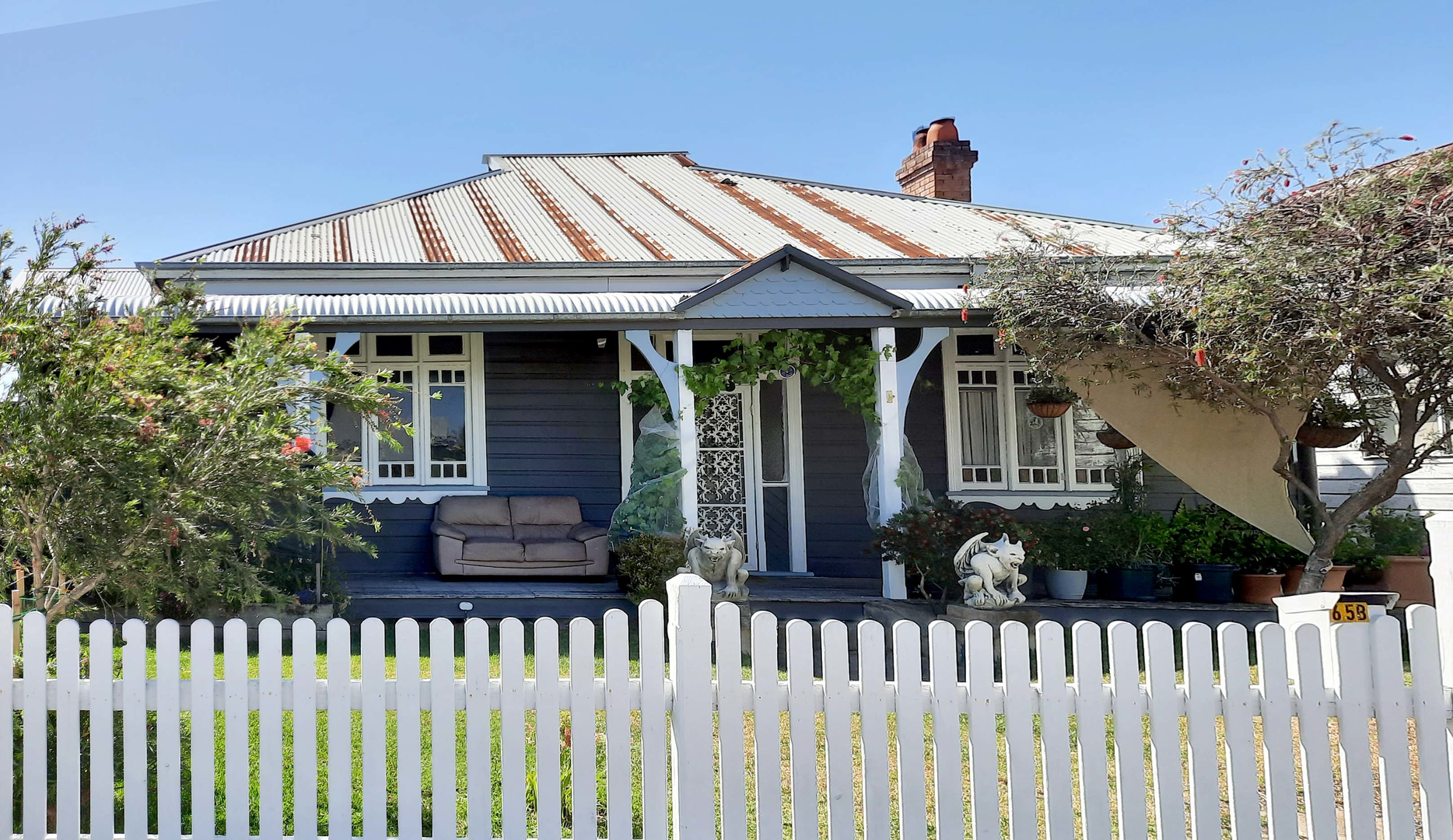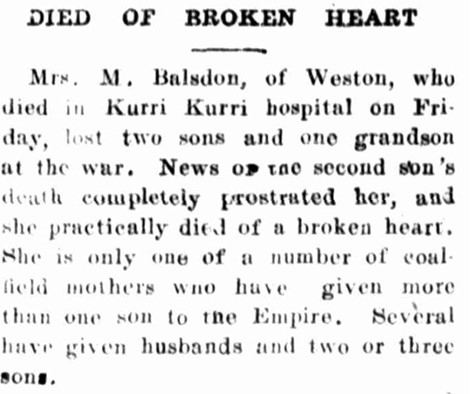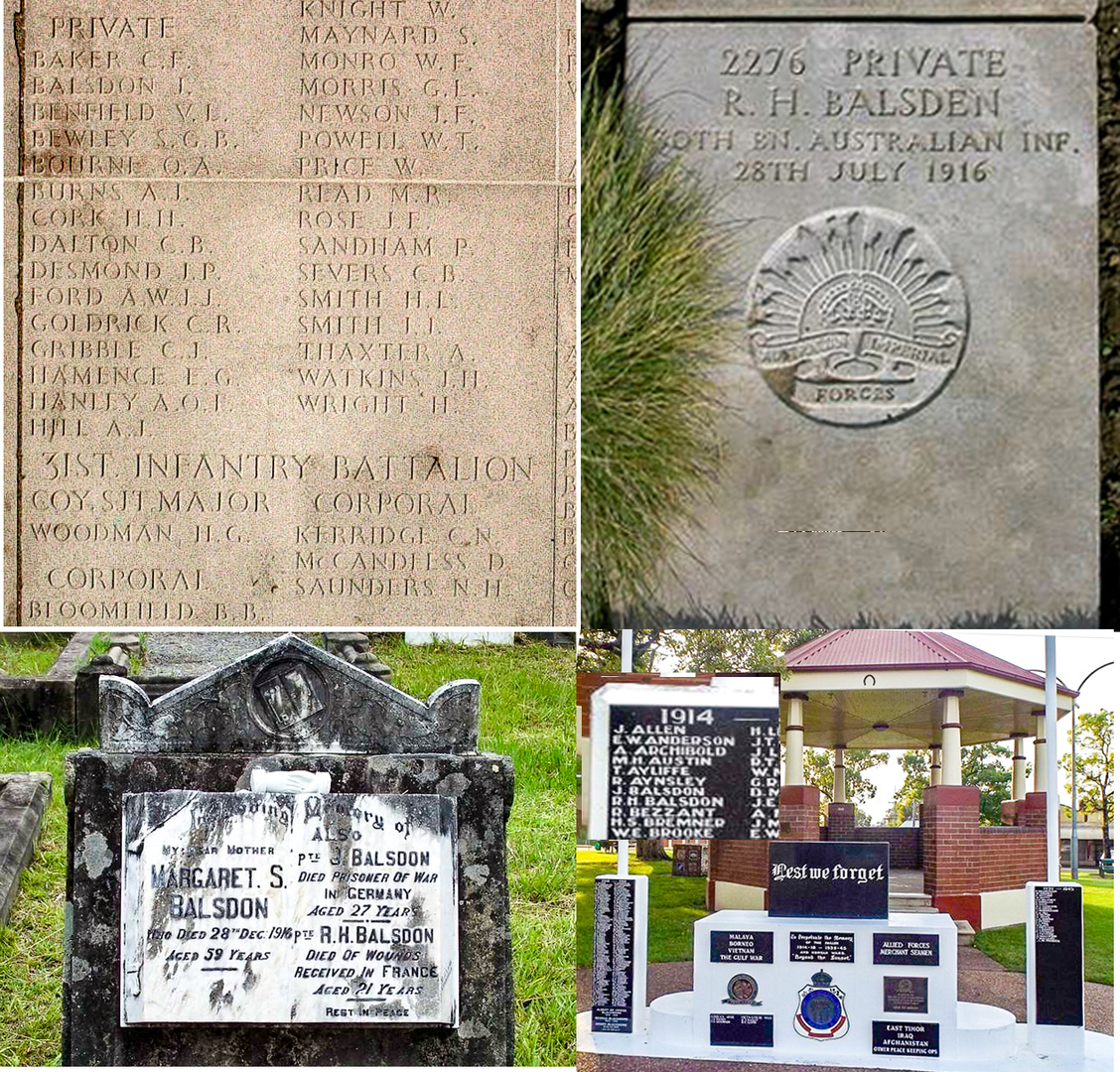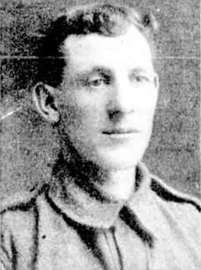
Joseph Tucker BALSDON
Eyes grey, Hair brown, Complexion dark
The Balsdons - A Fighting Family
Can you help us identify James Balsdon?
In 2008 a mass grave was found at Fromelles, a grave the Germans dug for 250 (Australian) bodies they recovered after the battle. James was Killed in Action at Fromelles and appeared on the German Death Lists. As part of the 30th Battalion he was positioned near where the Germans collected soldiers who were later buried at Pheasant Wood. There is a chance he might be identified, but we need help. We are still searching for suitable family DNA donors. If you know anything of contacts here in Australia or his relatives from Tynemouth, England, please contact the Fromelles Association. See the DNA box at the end of the story for what we do know about his family.
We sincerely thank descendant Ian Balsdon who contributed to the story.
From the coal mines in Northumberland, England to the coal mines in the Hunter Valley, New South Wales
James Balsdon and Margaret (nee Bell) lived in the coal mining area near Blyth, north of Tynemouth, England.
They had eight children:
- Grace 1875-1908 d UK
- George Bell 1880-1966 d UK
- Clara 1883-1949 d UK
- Joseph Tucker 1886-1976 d NSW
- James 1889-1916 d France
- John Turner 1892-1955 d UK
- Russell Henry 1895-1916 d France
- Blanche Mary 1898-1971 d NSW
James and his sons worked in the Northumberland coal mines - Joseph is in the 1901 census as being a pony driver in the mines at just 14 years old.
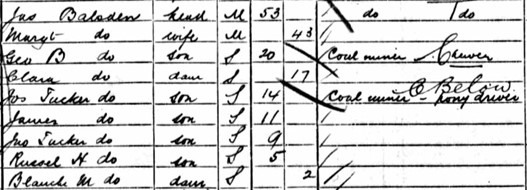
James, senior, died in 1906. Then, in 1912, the 54-year-old Margaret decided to migrate to Australia with James, Russell and Blanche. Joseph and his wife Margaret followed in July 1914. Grace, George, Clara and John remained in England with their families. Being a family of miners, they settled in the Australian coal mining centre of the Hunter Valley NSW. They lived in Weston, which is about 40 km NW of Newcastle.
Ian Balsdon remembers the home – There is a chimney (that you can’t see in this photo) on the left side where there was a fire and mantlepiece. When you walked in the house, the grand piano was on the right and the mantlepiece with deer horns on the left. The Balsdons love music and art. James and Russell worked in the mines, but Joseph’s enlistment papers cited that he worked as a “billiard marker”- a scorekeeper, not a miner.
All the sons head off to War
The three Aussie sons enlisted together on 13 September 1915 at West Maitland, NSW and were assigned to the 4th Reinforcements of the 30th Battalion. Their brother George and their nephew James had also enlisted back home in England. The Aussie sons embarked from Sydney, New South Wales on board HMAT A67 Orsova on 11 March 1916. The first group of 30th Battalion soldiers had left for Egypt in early November 1915.
The Balsdons joined with the rest of their battalion at Ferry Post in late April, where they spent their time continuing their training and guarding the Suez Canal. The camps were basic, with complaints of the heat, water supplies and flies. The 30th Battalion left Egypt for the Western Front on 16 June 1916 and arrived in Marseilles on 23 June. After landing, there was a 60+ hour train ride to Hazebrouck, 30 km from Fleurbaix. They arrived on 29 June and then were encamped in Morbecque.
Private F.R. Sharp (2134) wrote home about the trip:
“From the time we left Marseilles until we reached our destination was nothing but one long stretch of farms and the scenery was magnificent.” “France is a country worth fighting for.”
Training now included the use of gas masks and they also would have heard the heavy artillery from the front lines. On 8th July they were headed to the front lines, first to Estaires, 20 km, and the next day 11 km to Erquinghem, where they were billeted at Jesus Farm. They got their first ‘taste’ of being in the front lines at 9.00 PM on 10th July.
The Battle of Fromelles

A week later, they got orders for an attack, but it was postponed due to the weather.
Then just two days after that, the 29 officers and 927 other ranks of the 30th Battalion were into battle. The 30th Battalion’s role in the battle was to provide support for the attacking 31st and 32nd Battalions, digging trenches and providing carrying parties for supplies and ammunition. They would be called in as reserves if needed for the fighting. The 32nd’s charge over the parapet began at 5.53 PM and the 31st’s at 5.58 PM.
There were machine guns emplacements to their left and directly ahead at Delrangre Farm and there was heavy artillery fire in No-Man’s-Land. The initial assaults were successful and by 6.30 PM the Aussies were in control of the German’s 1st line system (Trench B in the diagram below), which was described as “practically a ditch with from 1 to 2 feet of mud and slush at the bottom”.
Source AWM4 23/49/12, 32nd Battalion War Diaries, July 1916, page 11
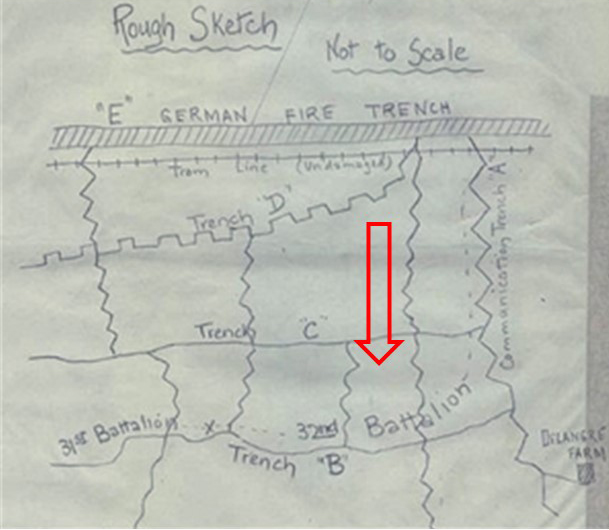
While the 30th’s role was to be in support, commanders on scene made the early decision to use them as much-needed reinforcements. A necessary act, but it had consequences as it interfered with the planned flow of supplies. By 8.30 PM the Australians’ left flank had come under heavy bombardment with high explosives and shrapnel. Return bombardment support was provided and they were told that “the trenches were to be held at all costs”.
Source AWM4 23/49/12, 32nd Battalion War Diaries, July 1916, page 12
When the 30th was ‘formally’ called to provide fighting support at 10:10 PM, Lieutenant-Colonel Clark of the 30th reported:
“All my men who have gone forward with ammunition have not returned. I have not even one section left.”
Fighting continued through the night. The Australians made a further charge at the main German line beyond Trench B, but they were low on grenades, there was machine gun fire from behind from the emplacement at Delangre Farm and they were so far advanced that they were getting shelled by both sides.
At 4.00 AM the Germans began an attack from the Australian’s left flank, bombing and advancing into Trench A (map). Given the Australian advances that had been made earlier, portions of the rear Trench E had been left almost empty, which then enabled the Germans to be in a position to surround the soldiers.
At 5.30 AM the Germans attacked from both flanks in force and with bombing parties. Having only a few grenades left, the only resistance the 31st could offer was with rifles. “The enemy swarmed in and the retirement across No Mans’ Land resembled a shambles, the enemy artillery and machine guns doing deadly damage.”
Source AWM4 23/48/12, 31st Battalion War Diaries, July 1916, page 29
By 10.00 AM on the 20th, the Germans had repelled the Australian attack and the 30th Battalion were pulled out of the trenches. The nature of this battle was summed up by Private Jim Cleworth (784) from the 29th:
"The novelty of being a soldier wore off in about five seconds, it was like a bloody butcher's shop".
Initial figures of the impact of the battle on the 30th were 54 killed, 230 wounded and 68 missing – for a battalion that was intended to be in ‘reserve’. To get some perspective of the battle, when Charles Bean, Australia’s official war historian, attended the battlefield two and half years later, he observed a large amount of bones, torn uniforms and Australian kit still on the battlefield.
The ultimate total for the 30th Battalion was that 125 soldiers were either killed or died from wounds and of this total 80 were missing/unidentified.
The Balsdons were hit hard in 1916

Joseph, Russell, George, Margaret, J Kneeling (grandson), James
James
Based on witness statements, James was well forward in the Australian advances. Private James Mansfield Payten (1327) stated:
“he was killed right under the parapet of German trenches he died almost at once I was along side him”
Private H V T Hodgins (2063) witness statement is equally as clear.
He was initially recorded as one of the many who were “missing in action”. His formal service record of January 1917 reports that he died while a Prisoner of War, but given the witness statements, the basis for what actually happened to James is uncertain.
Russell
Russell was seriously wounded during the battle - a gunshot wound in his arm and neck – but he did make it to the Australian lines either by stretcher or under his own power and he was taken to the casualty clearing station on 20th July. He was immediately evacuated by train to the 13th General Hospital in Boulogne, 100 km away.
His wounds were serious enough that he was unable to be saved and he passed away on 28th July. He was buried at the Boulogne Cemetery by the Reverend T.S. Gouge on 30 July. His final resting place is at the Boulogne Eastern Cemetery (Plot VIII, Row A, Grave No. 154), France.
Joseph
Joseph was also wounded, a gunshot wound that left him with a compound fracture of his left arm. He was evacuated to Southwark Hospital in England on 23 July. He did recover, but lost the use of his arm. Given the seriousness of his wounds, he was sent back to Australia in May 1917.
James Balsdon Kneeling
Margaret’s grandson, James, was with the Northumberland Fusiliers and was killed in August 1916.
George
George served with the 7th Battalion of the Northumberland Fusiliers. He is the only one who survived the War.
Margaret
Margaret died in December 1916, “of a broken heart” only months after the loss of her sons and grandson.
James, Russell and Joseph all received the Victory and British War Medals. James and Russell also received Memorial Plaques and Memorial Scrolls.
Their sister Blanche was in communication with the Army for years after the War, seeking to receive James’s and Russell’s War medals. There were ‘rules’ about who in the family was eligible for this – parents, eldest sibling, etc – and next-of-kin records on file with the Army would have been complicated by their multi-country basis and deaths in the family. She persisted and finally received the medals in 1943. Finally, some degree of closure for the loss of two of her brothers.
James is commemorated at V.C. Corner, Australian Cemetery Memorial at Fromelles and he and Russell at the Australian War Memorial, Canberra and the Kurri Kurri NSW War Memorial. Russell is buried in the Boulogne Cemetery, France.
What DID happen to James?
While Privates Payten’s and Hodgins’ witness statements seems clear enough about James’ fate, his official record in January 1917 says he died while a Prisoner of War.
Did he actually survive and was captured?
There is a long trail of communication about James, but it does not fit well with either the processes the Germans used in reporting Prisoners of War or the handling of soldiers’ bodies that they recovered. At the end of July 1916, there is German correspondence advising that James’ paybook had been sent to the Central Office of Left Property in Berlin, but they also issued advice, dated 2 August, that James “fell on 4.7.16 in the neighbourhood of Fromelles” (was this a typo?). This wording is typically used for the bodies that the Germans recovered from the battlefield. They also had his ID tag, which was returned later.
James’ name then appears on an 18 August German list of personal effects. In mid-September the Red Cross created an ‘index card’ that denotes James as a prisoner, but this is likely based on the assumption that if the Germans had his Paybook it must have meant that he was a Prisoner of War. There is also an undated, handwritten annotation, however, of “bel. Died”.
At the end of October James appears on three separate German Death Lists.
There are no communications from the Germans about him being a Prisoner of War, but in January 1917, he is officially declared by the Army as having died in Germany as a POW.
After the War, Captain Charles Mills made extensive efforts to locate all the Australians who died in POW camps. In one of his reports, 16 March 1919, he did note that James died on 20th July and that his ID disk had been returned, but there were no reports about James being processed or having died as a Prisoner of War. The last document about James is from 1920, long after his Service Record was filled in as having died while a POW. This one says he was “Killed in Action” on 20th July 1916.
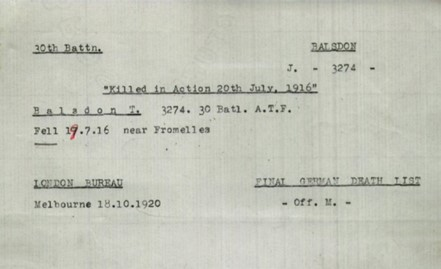
In all likelihood, James did die as described by his mates, the Germans recovered his ID tag and paybook and passed them on thru channels and presumably they buried him at Fromelles, possibly in the burial pit at Pheasant Wood that was discovered in 2008. As of 2024 26 of the 80 unidentified soldiers from the 30th Battalion who died at the battle have been found to be in the burial pit. 70 unidentified bodies remain from the 250 that were in the grave.
James could be one of these remaining soldiers. We need family DNA donors to be able to find out and be able to give James proper recognition. Specifically, we need a mtDNA donor, i.e. someone from a female to female to female line. It could be a living male, but he would need to have had an all female ancestral relationship as well.
DNA samples are being sought for family connections to
| Soldier | James Balsdon (1889-1916) |
| Parents | James Balsdon (1848-1906) Northumberland, England and Margaret Smith Bell (1857-1916), Weston, New South Wales |
| Siblings | Grace (1875-1908) Northumberland, England married Emil Kneeling (1865-?) b Dresden, Germany | ||
| George Bell (1880-1966) Northumberland, England married Emma Floyd Southern (1886-1965) | |||
| Clara (1883-1949) Northumberland, England married Arthur Morin (1875-1964) b Latvia | |||
| Joseph Tucker (1886-1976) d Kurri Kurri, New South Wales married Margaret Ellen Hindmarsh (1890-1963) d Kurri Kurri NSW | |||
| John Turner (1892-1955) d Lynemouth, Northumberland, England married Lily | |||
| Russell Henry (1895-1916) d Fromelles, France | |||
| Blanche Mary (1898-1971) d New South Wales married Clifford Yeomans |
| Grandparents | |||
| Paternal | James Balsdon (1826- ?) b Devon, England and Elizabeth (1811-?) | ||
| Maternal | George Bell (1824-1890) d Northumberland, England and Abigail Smith (1827-1910) d Northumberland, England |
Note. Joseph returned from the war and had three sons, Neville Norman, and twins James and Russell Henry.
Links to Official Records
The Fromelles Association would love to hear from you

Contacts
(Contact: royce@fromelles.info or geoffrey@fromelles.info).
(Contact: army.uwc@defence.gov.au or phone 1800 019 090).
Donations
If you are able, please contribute to the upkeep of this resource.
(Contact: bill@fromelles.info ).
